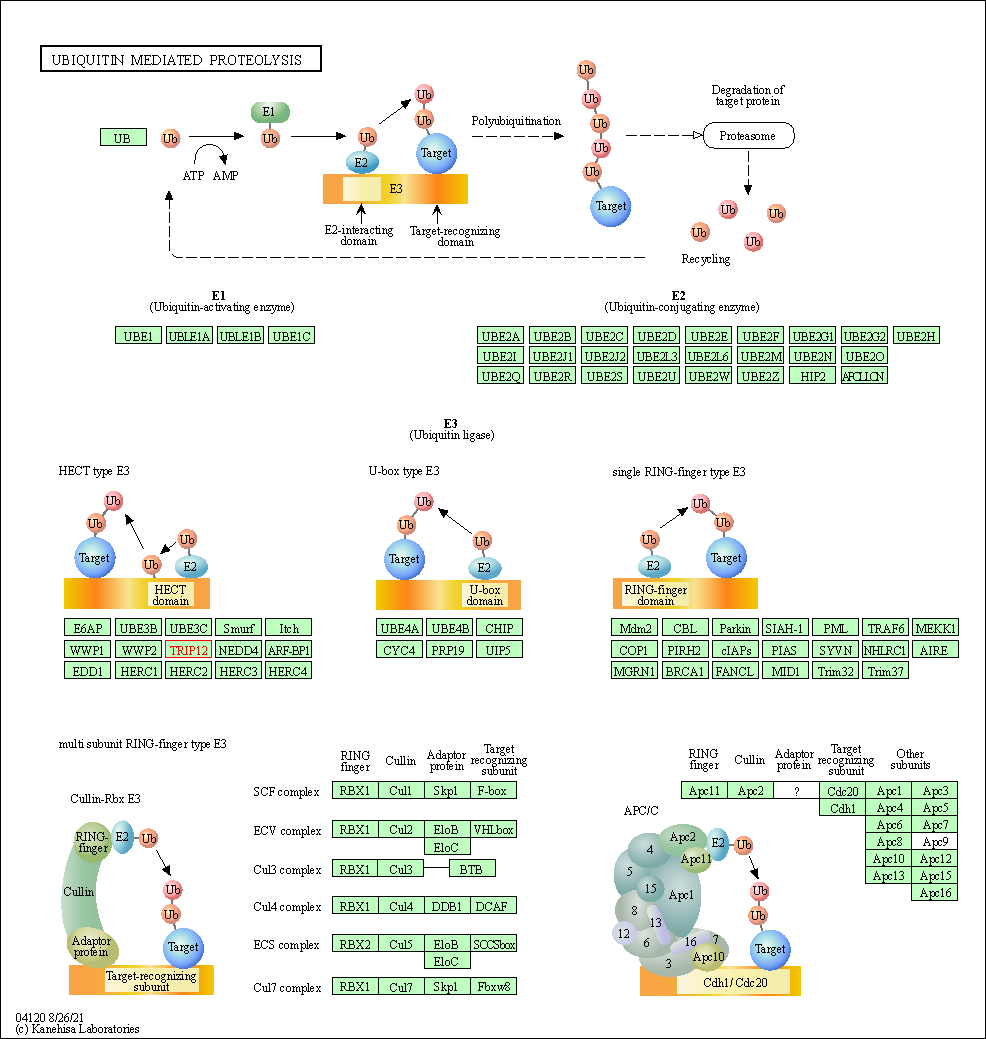Target Information
| Target General Information | Top | |||||
|---|---|---|---|---|---|---|
| Target ID |
T24714
(Former ID: TTDI00159)
|
|||||
| Target Name |
E3 ubiquitin-protein ligase TRIP12 (TRIP12)
|
|||||
| Synonyms |
ULF; Thyroid receptorinteracting protein 12; TRinteracting protein 12; TRIP12; E3 ubiquitinprotein ligase for Arf; E3 ubiquitinprotein ligase TRIP12
Click to Show/Hide
|
|||||
| Gene Name |
TRIP12
|
|||||
| Target Type |
Literature-reported target
|
[1] | ||||
| Function |
E3 ubiquitin-protein ligase involved inubiquitin fusion degradation (UFD) pathway and regulation of DNA repair. Part of the ubiquitin fusion degradation (UFD) pathway, a process that mediates ubiquitination of protein at their N-terminus,regardeless of the presence of lysine residues in target proteins. In normal cells, mediates ubiquitination and degradation of isoform p19ARF/ARF of CDKN2A, a lysine-less tumor suppressor required for p53/TP53 activation under oncogenic stress. In cancer cells, however, isoform p19ARF/ARF and TRIP12 are located in different cell compartments, preventing isoform p19ARF/ARF ubiquitination and degradation. Does not mediate ubiquitination of isoform p16-INK4a of CDKN2A. Also catalyzes ubiquitination of NAE1 and SMARCE1, leading to their degradation. Ubiquitination and degradation of target proteins is regulated by interaction with proteins such as MYC, TRADD or SMARCC1, which disrupt the interaction between TRIP12 and target proteins. Acts as a key regulator of DNA damage response by acting as a suppressor of RNF168, an E3 ubiquitin-protein ligase that promotes accumulation of 'Lys-63'-linked histone H2A and H2AX at DNA damage sites, thereby acting as a guard against excessive spreading of ubiquitinated chromatin at damaged chromosomes.
Click to Show/Hide
|
|||||
| BioChemical Class |
Carbon-nitrogen ligase
|
|||||
| UniProt ID | ||||||
| EC Number |
EC 2.3.2.26
|
|||||
| Sequence |
MSNRPNNNPGGSLRRSQRNTAGAQPQDDSIGGRSCSSSSAVIVPQPEDPDRANTSERQKT
GQVPKKDNSRGVKRSASPDYNRTNSPSSAKKPKALQHTESPSETNKPHSKSKKRHLDQEQ QLKSAQSPSTSKAHTRKSGATGGSRSQKRKRTESSCVKSGSGSESTGAEERSAKPTKLAS KSATSAKAGCSTITDSSSAASTSSSSSAVASASSTVPPGARVKQGKDQNKARRSRSASSP SPRRSSREKEQSKTGGSSKFDWAARFSPKVSLPKTKLSLPGSSKSETSKPGPSGLQAKLA SLRKSTKKRSESPPAELPSLRRSTRQKTTGSCASTSRRGSGLGKRGAAEARRQEKMADPE SNQEAVNSSAARTDEAPQGAAGAVGMTTSGESESDDSEMGRLQALLEARGLPPHLFGPLG PRMSQLFHRTIGSGASSKAQQLLQGLQASDESQQLQAVIEMCQLLVMGNEETLGGFPVKS VVPALITLLQMEHNFDIMNHACRALTYMMEALPRSSAVVVDAIPVFLEKLQVIQCIDVAE QALTALEMLSRRHSKAILQAGGLADCLLYLEFFSINAQRNALAIAANCCQSITPDEFHFV ADSLPLLTQRLTHQDKKSVESTCLCFARLVDNFQHEENLLQQVASKDLLTNVQQLLVVTP PILSSGMFIMVVRMFSLMCSNCPTLAVQLMKQNIAETLHFLLCGASNGSCQEQIDLVPRS PQELYELTSLICELMPCLPKEGIFAVDTMLKKGNAQNTDGAIWQWRDDRGLWHPYNRIDS RIIEQINEDTGTARAIQRKPNPLANSNTSGYSESKKDDARAQLMKEDPELAKSFIKTLFG VLYEVYSSSAGPAVRHKCLRAILRIIYFADAELLKDVLKNHAVSSHIASMLSSQDLKIVV GALQMAEILMQKLPDIFSVYFRREGVMHQVKHLAESESLLTSPPKACTNGSGSMGSTTSV SSGTATAATHAAADLGSPSLQHSRDDSLDLSPQGRLSDVLKRKRLPKRGPRRPKYSPPRD DDKVDNQAKSPTTTQSPKSSFLASLNPKTWGRLSTQSNSNNIEPARTAGGSGLARAASKD TISNNREKIKGWIKEQAHKFVERYFSSENMDGSNPALNVLQRLCAATEQLNLQVDGGAEC LVEIRSIVSESDVSSFEIQHSGFVKQLLLYLTSKSEKDAVSREIRLKRFLHVFFSSPLPG EEPIGRVEPVGNAPLLALVHKMNNCLSQMEQFPVKVHDFPSGNGTGGSFSLNRGSQALKF FNTHQLKCQLQRHPDCANVKQWKGGPVKIDPLALVQAIERYLVVRGYGRVREDDEDSDDD GSDEEIDESLAAQFLNSGNVRHRLQFYIGEHLLPYNMTVYQAVRQFSIQAEDERESTDDE SNPLGRAGIWTKTHTIWYKPVREDEESNKDCVGGKRGRAQTAPTKTSPRNAKKHDELWHD GVCPSVSNPLEVYLIPTPPENITFEDPSLDVILLLRVLHAISRYWYYLYDNAMCKEIIPT SEFINSKLTAKANRQLQDPLVIMTGNIPTWLTELGKTCPFFFPFDTRQMLFYVTAFDRDR AMQRLLDTNPEINQSDSQDSRVAPRLDRKKRTVNREELLKQAESVMQDLGSSRAMLEIQY ENEVGTGLGPTLEFYALVSQELQRADLGLWRGEEVTLSNPKGSQEGTKYIQNLQGLFALP FGRTAKPAHIAKVKMKFRFLGKLMAKAIMDFRLVDLPLGLPFYKWMLRQETSLTSHDLFD IDPVVARSVYHLEDIVRQKKRLEQDKSQTKESLQYALETLTMNGCSVEDLGLDFTLPGFP NIELKKGGKDIPVTIHNLEEYLRLVIFWALNEGVSRQFDSFRDGFESVFPLSHLQYFYPE ELDQLLCGSKADTWDAKTLMECCRPDHGYTHDSRAVKFLFEILSSFDNEQQRLFLQFVTG SPRLPVGGFRSLNPPLTIVRKTFESTENPDDFLPSVMTCVNYLKLPDYSSIEIMREKLLI AAREGQQSFHLS Click to Show/Hide
|
|||||
| 3D Structure | Click to Show 3D Structure of This Target | AlphaFold | ||||
| Cell-based Target Expression Variations | Top | |||||
|---|---|---|---|---|---|---|
| Cell-based Target Expression Variations | ||||||
| Different Human System Profiles of Target | Top |
|---|---|
|
Human Similarity Proteins
of target is determined by comparing the sequence similarity of all human proteins with the target based on BLAST. The similarity proteins for a target are defined as the proteins with E-value < 0.005 and outside the protein families of the target.
A target that has fewer human similarity proteins outside its family is commonly regarded to possess a greater capacity to avoid undesired interactions and thus increase the possibility of finding successful drugs
(Brief Bioinform, 21: 649-662, 2020).
Human Tissue Distribution
of target is determined from a proteomics study that quantified more than 12,000 genes across 32 normal human tissues. Tissue Specificity (TS) score was used to define the enrichment of target across tissues.
The distribution of targets among different tissues or organs need to be taken into consideration when assessing the target druggability, as it is generally accepted that the wider the target distribution, the greater the concern over potential adverse effects
(Nat Rev Drug Discov, 20: 64-81, 2021).
Human Pathway Affiliation
of target is determined by the life-essential pathways provided on KEGG database. The target-affiliated pathways were defined based on the following two criteria (a) the pathways of the studied target should be life-essential for both healthy individuals and patients, and (b) the studied target should occupy an upstream position in the pathways and therefore had the ability to regulate biological function.
Targets involved in a fewer pathways have greater likelihood to be successfully developed, while those associated with more human pathways increase the chance of undesirable interferences with other human processes
(Pharmacol Rev, 58: 259-279, 2006).
Biological Network Descriptors
of target is determined based on a human protein-protein interactions (PPI) network consisting of 9,309 proteins and 52,713 PPIs, which were with a high confidence score of ≥ 0.95 collected from STRING database.
The network properties of targets based on protein-protein interactions (PPIs) have been widely adopted for the assessment of target’s druggability. Proteins with high node degree tend to have a high impact on network function through multiple interactions, while proteins with high betweenness centrality are regarded to be central for communication in interaction networks and regulate the flow of signaling information
(Front Pharmacol, 9, 1245, 2018;
Curr Opin Struct Biol. 44:134-142, 2017).
Human Similarity Proteins
Human Tissue Distribution
Human Pathway Affiliation
Biological Network Descriptors
|
|
| Protein Name | Pfam ID | Percentage of Identity (%) | E value |
|---|---|---|---|
| Importin subunit alpha-1 (KPNA2) | 22.727 (55/242) | 3.00E-03 | |
| Importin subunit alpha-7 (KPNA6) | 27.215 (43/158) | 5.00E-03 |
|
Note:
If a protein has TS (tissue specficity) scores at least in one tissue >= 2.5, this protein is called tissue-enriched (including tissue-enriched-but-not-specific and tissue-specific). In the plots, the vertical lines are at thresholds 2.5 and 4.
|

| KEGG Pathway | Pathway ID | Affiliated Target | Pathway Map |
|---|---|---|---|
| Ubiquitin mediated proteolysis | hsa04120 | Affiliated Target |

|
| Class: Genetic Information Processing => Folding, sorting and degradation | Pathway Hierarchy | ||
| Degree | 1 | Degree centrality | 1.07E-04 | Betweenness centrality | 0.00E+00 |
|---|---|---|---|---|---|
| Closeness centrality | 1.59E-01 | Radiality | 1.23E+01 | Clustering coefficient | 0.00E+00 |
| Neighborhood connectivity | 3.00E+00 | Topological coefficient | 1.00E+00 | Eccentricity | 14 |
| Download | Click to Download the Full PPI Network of This Target | ||||
| Target Regulators | Top | |||||
|---|---|---|---|---|---|---|
| Target-interacting Proteins | ||||||
| References | Top | |||||
|---|---|---|---|---|---|---|
| REF 1 | Ubiquitin-specific protease 7 accelerates p14(ARF) degradation by deubiquitinating thyroid hormone receptor-interacting protein 12 and promotes hep... Hepatology. 2015 May;61(5):1603-14. | |||||
If You Find Any Error in Data or Bug in Web Service, Please Kindly Report It to Dr. Zhou and Dr. Zhang.

